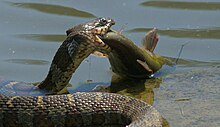食鱼动物
(重定向自食魚性)
食鱼动物(piscivore/ˈpɪsɪvɔːr/)是指以鱼类为主食的肉食动物。鱼类为早期四足类(两栖类)的主食,再来为食虫动物,直到演化成爬虫类才出现草食性动物。[1]

某些动物如海狮和短吻鳄并不完全以鱼类为食,同样也会捕捉水中的无脊椎动物或是陆地生物。但有些动物如兔唇蝠科的蝙蝠、恒河鳄则完全只以鱼类为食。另外有些动物,如章鱼、鱿鱼、蜘蛛、鲨鱼、鲸豚、灰熊、美洲豹、狼、蛇、乌龟、海鸥等,也会捕捉鱼类为食,但仅占所有食物来源的一部分而已。
食鱼动物能够帮助将一个生态系统的能量移转至另一个生态系统,。在阿拉斯加一带的灰熊以鲑鱼为食,而进食后排放在森林的粪便与鲑鱼的残骸,可以将来自海洋的高价值养份(包括大量的氮以及磷)带到溪边的林地中,滋养当地其他的动植物;借此将海洋生态系统的养分传递至森林生态系统、湖泊生态系统与溪流生态系统之中。[2]
现存的食鱼动物范例
编辑已绝种的食鱼动物范例
编辑部分已绝种的动物透过化石的状态分析得以认定其为食鱼动物,甚至部分种类直接保留了以鱼类为主食的直接证据。
参见
编辑参考文献
编辑- ^ Sahney, S., Benton, M. J. & Falcon-Lang, H. J. Rainforest collapse triggered Pennsylvanian tetrapod diversification in Euramerica (PDF). Geology. 2010, 38 (12): 1079–1082 [2018-06-02]. doi:10.1130/G31182.1. (原始内容存档于2011-10-11). (页面存档备份,存于互联网档案馆)
- ^ Helfield, J. & Naiman, R. Keystone Interactions: Salmon and Bear in Riparian Forests of Alaska (PDF). Ecosystems. 2006, 9 (2): 167–180 [2018-06-02]. doi:10.1007/s10021-004-0063-5. (原始内容存档 (PDF)于2012-04-26). (页面存档备份,存于互联网档案馆)
- ^ Bright, Michael. The private life of sharks : the truth behind the myth. Mechanicsburg, PA: Stackpole Books. 2000. ISBN 0-8117-2875-7.[页码请求]
- ^ 4.0 4.1 Hart, Paul. Handbook of Fish Biology and Fisheries. 350 Main Street, Malden, MA 02148: Blackwell Publishing. 2002: 267–283. ISBN 0632054123.
- ^ 5.0 5.1 Sereno, Paul C.; Beck, Allison L.; Dutheil, Didier B.; Gado, Boubacar; Larsson, Hans C. E.; Lyon, Gabrielle H.; Marcot, Jonathan D.; Rauhut, Oliver W. M.; Sadleir, Rudyard W.; Sidor, Christian A.; Varricchio, David D.; Wilson, Gregory P.; Wilson, Jeffrey A. A long-snouted predatory dinosaur from africa and the evolution of spinosaurids. Science. 1998, 282 (5392): 1298–302. Bibcode:1998Sci...282.1298S. PMID 9812890. doi:10.1126/science.282.5392.1298.
- ^ Dal Sasso, C.; Maganuco, S.; Cioffi, A. A neurovascular cavity within the snout of the predatory dinosaur Spinosaurus. 1st International Congress on North African Vertebrate Palaeontology. Muséum national d'Histoire naturelle. 26 May 2009 [22 September 2010]. (原始内容存档于2019-04-11). (页面存档备份,存于互联网档案馆)
- ^ Devlin, Hannah. Meet Boar, Rat and Pancake: the ancient, giant crocodiles found in Sahara. Times Online. November 20, 2009.
- ^ Bennett, S.C. The Pterosaurs of the Niobrara Chalk. The Earth Scientist. 1994, 11 (1): 22–25.
- ^ Cope, E. D. Synopsis of the extinct Batrachia, Reptilia and Aves of North America, Part I. Transactions of the American Philosophical Society. 1869, 14: 44–55 [2018-06-02]. doi:10.5962/bhl.title.60482. (原始内容存档于2017-11-08). (页面存档备份,存于互联网档案馆)
- ^ Xiphactinus audax Leidy. [2018-06-02]. (原始内容存档于2009-10-30). (页面存档备份,存于互联网档案馆)